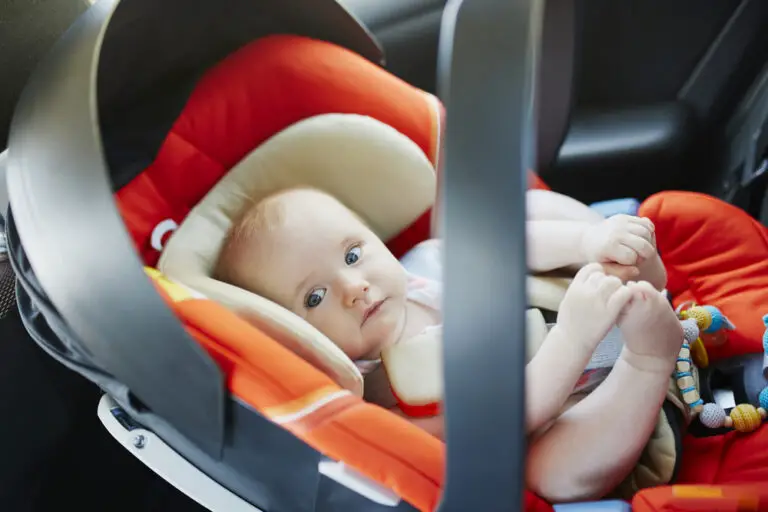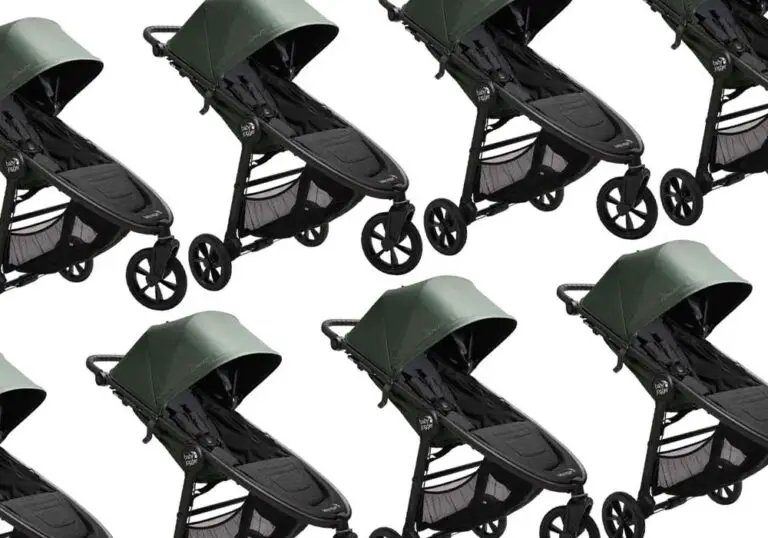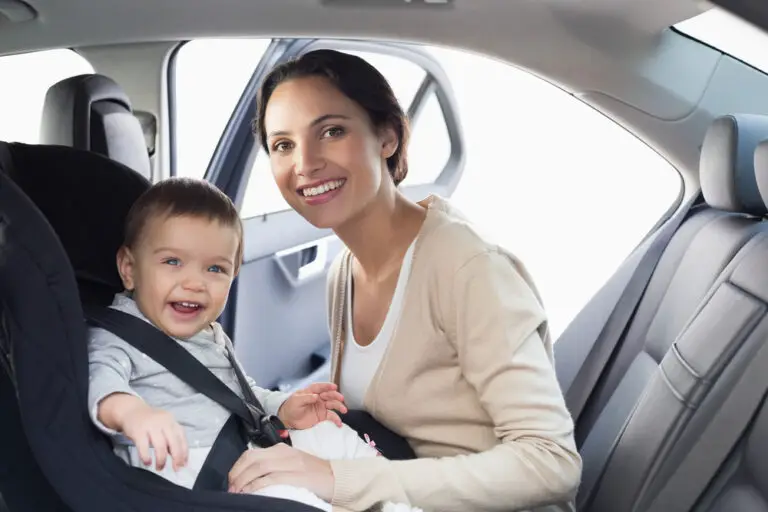California Car Seat Laws 2024 (Rear, Forward & Booster)

Under California car seat laws, all children under the age of 8 years have to be secured in a car seat. Those younger than 8 years but at least 4’9” tall can wear a seat belt.
A first offense carries a penalty of $100 while a second or subsequent offense carries a fine of $250.
Disclaimer: This content does not constitute legal advice. It is solely for informational purposes. Always check the original source of the law for the latest version.
- Rear-Facing
- Forward-Facing
- Booster
- Front Seat
- Seat Belt
- Taxi Seat
- Ridesharing Seat
- Replacement
- Alone in Car
- Choosing a Seat
- Installation Help
California Car Seat Laws
California Rear-Facing Car Seat Law
According to the rear-facing car seat law in California, a child under the age of 2 years, weighing less than 40 pounds and shorter than 40 inches, must be secured in a rear-facing seat. (1) The seat must be installed as per the car seat manufacturer’s instructions.
Though the rear-facing car seat age in California is newborn to 2 years, an infant should continue riding in their rear-facing seat till they reach their maximum weight or height limit set by the manufacturer.
Violating California rear-facing child seat law carries a penalty of $100 for the first offense and $250 for a second offense and subsequent offense, plus court costs. (2) If the parent or legal guardian is present with the child in the vehicle, the vehicle driver will not be responsible.
Age: Newborn to 2 years
Height: Less than 40 inches
Weight: Less than 40 pounds
Penalty: $100 for a first-time, $250 for a second or subsequent violation
California Forward-Facing Car Seat Law
There is no definite forward-facing car seat law in California. But a child older than 2 years and who has outgrown their rear-facing seat should be secured in a forward-facing seat with a harness. (1)
A specific forward-facing car seat age in California is absent. Your child should continue riding in a forward-facing seat till they reach the maximum weight or height limit of the seat prescribed by the manufacturer.
While there is no California forward-facing child seat law, a violation of California car seat regulations will be penalized.
The first offense will be fined $100, while a second and subsequent offense will attract a penalty of $250 plus court costs. (2) The motor vehicle driver will not be responsible if the child is traveling with their parent or legal guardian.
Age: Older than 2 years
Height: 40+ inches
Weight: 40+ pounds
Penalty: $100 for a first-time, $250 for a second or subsequent violation
California Booster Seat Law
According to the child booster seat law in California, children who are less than 8 years old, shorter than 4’9” and who have outgrown their forward-facing seats can ride in booster seats. (1) Depending on your requirements, you can choose a high back or backless booster seat
The booster seat age in California is 8 years. But you should keep your child in a booster seat till they cross its height or weight limits set by the manufacturer.
There is a fine for violating California booster seat requirements.. A first violation carries a $100 fine while a second and subsequent violation carries a penalty of $250 plus court costs. (2) Children who are physically or medically unable to use a car seat are exempt from complying with these requirements.
Age: Less than 8 years
Height: Shorter than 4’9”
Penalty: $100 for a first-time, $250 for a second or subsequent violation
California Child Front Seat Law
According to the child front seat law in California, children younger than 8 years must travel in the backseat. (1)
The front seat age in California is 8 years. However, the California Department of Public Health recommends that children ride in the backseat till they are 13 years old.
Under certain circumstances, a child can ride in the front seat in a child restraint appropriate for their height and weight. If there is no rear seat, or the rear seats are side-facing jump seats or rear-facing seats, then a child can ride in the front seat. (3)
You can also put your child in the front seat if all rear seats are occupied by children 7 years old or younger or if there are medical reasons.
A violation of these requirements will be fined $100 for the first offense and $250 for a second offense and subsequent offense. (2)
Age: 8+ years
Penalty: $100 for a first-time, $250 for a second or subsequent violation
California Child Seat Belt Law
According to the child seat belt law in California, a child between the ages of 8 to 16 years has to wear an adult safety belt. (4) This applies whether they are in the backseat or the front seat.
Children who are younger than 8 years but at least 4’9” tall can also wear a seat belt.
The requirements of this provision are met when the seat belt properly fits across the chest and thighs of the child. Seat belt rules in California are primary enforcement laws. A law enforcement officer can stop your vehicle if your child is not wearing a seat belt.
Violating California children’s seat belt law for the first time entails a fine of $100. A second violation carries a penalty of $250. (5)
Age: 8 to 16 years
Height: At least 4’9”
Penalty: $100 for a first-time, $250 for a second or subsequent violation
California Taxi Child Seat Law
According to the taxi child seat law in California, taxis are required to have a child passenger safety system in place. California child seat laws do not exempt them from their purview.
Under California state law, all children under 8 years of age have to be properly secured in a car seat. (1) If the parent or legal guardian of the child is present in the vehicle, then they will be held responsible, and not the taxi driver, if the child is not using a car seat.
The driver does not have to provide a taxi child seat in California. It is best if you arrange an appropriate car seat before traveling with your child. Depending on the child’s age, you can choose a rear-facing, forward-facing, or a booster car seat.
California Ridesharing Child Seat Law
There is no clear ridesharing child seat law in California.
Car seat laws in California require all children under the age of 8 to be restrained in an appropriate car seat. (1) Only those who are unable to use a car seat due to physical or medical reasons are exempt. However, there is no mention of ridesharing services such as Uber or Lyft.
The best option in this case is for you, the [parent/caregiver to provide a child seat. For babies under 2 years, this means a rear-facing car seat. Those who have outgrown these seats can use a forward-facing car seat. Older children who have outgrown their forward-facing seats need to ride in booster seats.
Check with the driver if they have a car seat or carry your own.
California Child Seat Replacement Law
According to the child seat replacement law in California, insurance companies are obligated to replace your child safety seat if it is involved in an accident in California. (6)
The National Highway Traffic Safety Administration (NHTSA) recommends replacing the seat after an accident, especially after a moderate or severe crash. In case of a low impact accident, there is no urgent need to replace the car seat. A low impact crash is where no passenger is injured, the door nearest to the car seat is not damaged and the seat itself shows no visible damage.
Apart from child seat replacement after an accident, you must also replace it after it has expired or has been recalled. Check the manufacturer’s website or car seat sticker for more information.
Leaving Child in The Car in California
According to the law on leaving a child in a vehicle in California, it is illegal to leave a child under 6 years of age unsupervised and unattended in a motor vehicle in a risky situation or if the keys are in the ignition or the engine is running. (7) There should be a person 12 years of age or older to supervise the child.
The most common danger of leaving a child unattended in a vehicle is heat stroke. Temperature inside the vehicle can rise rapidly. Since children’s bodies heat up faster than adults, they are at a great risk of suffering a heat stroke.
Leaving a child in the car in California is punishable with a fine of $100. If the child suffers serious injury or dies, the person responsible will be charged under child abandonment and neglect. They may be imprisoned.
Choosing a Child Car Seat in California
When choosing a car seat in California, you must ensure that you adhere to the relevant child seat requirements in California. To find the best child seat, you can refer to the recommendations of the California Department of Public Health.
From the time your child is born till they turn at least 2 years old, an infant rear-facing car seat is the best car seat to use in California. They can then move to a forward-facing seat with a harness. After they outgrow these, they should use booster seats. A high back or backless seat is the best booster seat to use in California.
Car Seat Installation Help in California
You must install your car seat as per the manufacturer’s instructions. In addition, you also have to refer to your vehicle’s manual. All this can seem complicated and you may not always succeed in installing the car seat correctly.
To help you with it, there are different stations with certified Child Passenger Safety (CPS) technicians. They help you with the installation and inspection of child passenger safety seats in California. Some of these stations are:
- Santa Clara County
- Car Seat Program, Scotts Valley Fire District
- Sanger Police Department
- Danville Police Department
- 4Cs of Alameda County
- Contra Costa County
- Walnut Creek Police Department
California Car Seat Safety Resources
- California Department of Public Health: The Department’s information brochure explains the law and contains useful details about each type of car seat, how to install them and best practices for car seat safety.
- Office of Traffic Safety: It has simplified the law and also has resources for choosing a car seat and getting it installed
- County of Los Angeles, Department of Public Health: It is a comprehensive resource for child passenger safety containing safety tips, car seat recommendations and child seat belt best practices.
- Safe Kids California: The California chapter of Safe Kids Worldwide, it provides a detailed list of how to use each type of car seat and at what stage of a child’s growth.
FAQ
How long should a child ride in a rear-facing car seat in California?
A child should ride in a rear-facing car seat till the age of 2 years or till they exceed the height and weight limits of the seat.
Can you put a rear-facing car seat in the front seat in California?
No, you cannot put a rear-facing seat in the front seat if a backseat is available. If you do put it in front, the front seat airbag must be deactivated.
Can you put a rear-facing car seat in the middle rear seat in California?
You can put a rear-facing car seat in the middle rear seat but it must fit properly. Check the car seat as well as your vehicle’s manuals.
When can a baby face forward in a car seat in California?
A child can face forward after they turn 2 years old or outgrow the maximum height or weight limits of their rear-facing seat as set by the manufacturer.
How old for a booster seat in California?
Children who are under the age of 8 years and shorter than 4’9” should ride in a booster seat once they outgrow their forward-facing seat.
When to use a backless booster seat in California?
You can use a backless booster seat if your vehicle seat has a headrest and the child’s ears are not higher than the seat back.
When can a child sit in the front seat with a booster in California?
Children under the age of 8 years must ride in the backseat. They can ride in the front seat with a booster if the backseat is not available or is occupied by other children under 7 years old.
When can a child stop using a booster seat in California?
A child can stop using a booster seat when they turn 8 years old or reach at least 4’9” in height. They can then start using the seatbelt.
When can a child sit in the front seat in California?
A child can sit in the front seat after they turn 8 years old. They can also sit in the front seat in an appropriate child restraint if there is no backseat.
When to switch from 5 point harness to a seat belt in California?
When the child outgrows the height and weight limits of the 5-point harness, they can switch to wearing a seat belt in a booster seat.
When can a child use a regular seat belt in California?
Under the law, a child can start using a regular adult seat belt once they are 8 years old or stand at least 4’9” tall.
Do you need a car seat in a taxi in California?
Yes, taxis are required to have a car seat. It is recommended that you carry your own car seat for maximum protection of your child.
Do you need a car seat in a Uber in California?
The law does not mention if it applies to Uber. But the caregiver should provide a federally approved and appropriate car seat for securing the child.
Do you need a car seat in a Lyft in California?
The law does not state if it applies to Lyft. But the caregiver should provide an appropriate car seat to ensure the child’s safety.

Rishima Rawat
Rishima Rawat is a lawyer and legal writer with over six years of writing and legal experience. She earned her LLB degree from the West Bengal National University of Juridical Sciences, Kolkata. With a passion for child safety, she’s written extensively about the U.S. car seat laws in ParentingMode. She collaborates with businesses and law firms globally, enhancing their online content. Her insights are also published in legal journals like RGNUL, NLIU, and RMLNLU Law Review. Committed to the cause of education, she has volunteered with IDIA, which helps underprivileged children in India to access legal education. She has also worked with Enhelion Knowledge Ventures, a leading legal ed-tech platform in India that provides students with affordable courses in law. Fluent in English and Hindi with elementary proficiency in Spanish, Rishima combines her legal expertise with a dedication to child safety.






